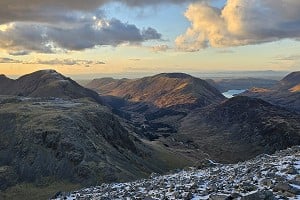
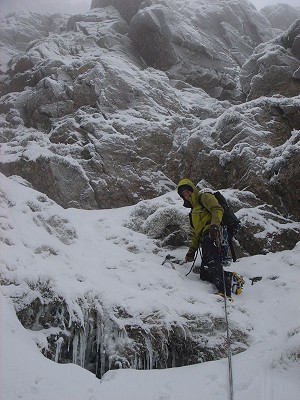
An early season flurry of mixed and ice climbing took place in North Wales and the Lake District. I finished my teaching term, and eagerly took to the Cumbrian hills, revelling in the fact that superb climbing was available within two hours' drive of my front door in Yorkshire. On the first sortie, my friend and colleague Toby Spence took me to his mother's house in Keswick to enable an early getaway. And so it was that an early rise led to a slithery drive up Borrowdale and the familiarly breathless, sweaty 'first walk-in of the season'.
Toby and I crested the ridge at the col of Windy Gap, fulfilling its name amply as wind-blown snow careered through the notch between Great Gable and Green Gable. Dropping down on its northern side, we suddenly found ourselves in calmer air, standing on drifts of snow dumped from the arcing blast. Crampons were donned, and we turned to the dark, forbidding crags disappearing off into the clouds above us. We were looking for Central Gully, which the guidebook assured us would offer a good outing at grade III, with a number of harder optional final pitches. In the poor visibility, we got a little confused, believing the crag to be smaller than it actually was. And then, suddenly, I recognised the dizzying wall of Engineers Slabs soaring into the gloom. 'Thank God we're not planning on going up there', we both said, more or less simultaneously.
Toby took up the lead. He is the Director of Learning at my school, and father to two small imps who refer to me as 'Uncle Tommy', so it was both pleasing and slightly surreal to see him in this new setting: helmeted, tooled-up and burrowing upwards through the icy chimney. The conditions were slightly curious: it was bitterly cold, so the turf was well-frozen, but the snow had not transformed and its thick powdery mantle was more a hindrance than a help. Furthermore, any moisture seemed to have frozen in the ground rather than growing into useful drapes of ice. All of this made for quite physical climbing, and Toby outflanked the second chimney before belaying on a ledge on the left. My pitch took me up what the guide described as 'easier snow' – in these conditions steep mossy ground – leading up to a rock island below the impressive headwall of the gully.
We now decided to take the Smart Exit, a grade IV,4 variation up leftwards. Toby led up a series of ledges and walls before coming up against the impasse of the final headwall. He teetered, cheek against the rock, with the drop of over 100m plunging into the mist behind him. “Where do you think I go now?” He then noticed a rising fault traversing hard left into the bottom of the final chimney groove. Before long he was happily belayed in a niche below a chockstone. “This next bit looks interesting, Tom”.
The wind rose as I moved up to join him, blowing spindrift in my face and down my neck, and I was slightly nervous about what lay ahead. The guidebook spoke of a convenient 10m slug of ice, but under the lean conditions what I was presented with was a bulging boulder-choke leading into a steep chimney. “Watch out Toby, if I slip off these moves my crampons will ruin your looks!” I handed him the sharp bulldog-hook that was hanging at my waist, not keen to be neutered in the event of a clattering fall. A series of sharp pulls from hooked placements led to a disconcerting mantle into the snowy upper groove.
Afterwards, the wind stinging our faces, we wandered through the flying clouds up to the desolate summit, with its memorial to those killed in the First World War. As we paused on top, the mirk suddenly dropped below us, and we were bathed in bright late-afternoon sunshine. Better still, looking back towards Gable Crag, our shadows were flung out onto the heaving sea of mist, their elongated heads each ringed by the multi-coloured glory of a Broken Spectre.
Three days later, I once again found myself on my way to the foot of Gable Crag, this time in the company of Nick Wallis and Dave Hollinger. Nick is in the British Ski Mountaineering team, and Dave is a fully qualified Mountain Guide, so I was steaming from every vent after following their cracking pace to Windy Gap. The morning was crystal clear and still, and I was eagerly playing my role as local guide, having just been there with Toby. This time, however, Engineers Slabs (VI,7) was on the agenda, and I was excited about taking on this 'big tick' in the company of a strong team. We had all been out together the previous day, climbing the classic Bowfell Buttress (V,6), and I was starting to feel more confident as rusty mixed climbing skills got dusted off. Nevertheless, I was keen not to take the crux pitch. Looking at the guidebook I decided that the middle of the three pitches sounded the hardest, and I therefore offered to lead the last one. The consciousness of this decision was to prove ironic given what happened later on in the day.
We scrambled up leftwards from close to the foot of Central Gully, admiring the slanting off-width that characterises the first pitch of the otherwise unpromisingly named Trundle Ridge (VII,7). Soon we were standing at the foot of the wall (and it really is more of a wall than a slab – it's pretty steep!). A series of inspiring lines seared their way skywards: Jabberwock (VII,7), Troll (VII,8) and Snicker Snack (VII,9). In the middle of it all – the strongest line on the crag – Engineers Slabs takes you up a wide crack and groove for a pitch (25m, technical 7), before heading right a couple of metres into a narrower continuation crack, which leads very steeply to the foot of the final deep V-groove(25m, 7). The final pitch either takes the V-groove itself (15m, 6) or you can take cracks across the left wall for the Arete Finish (20m, 7).
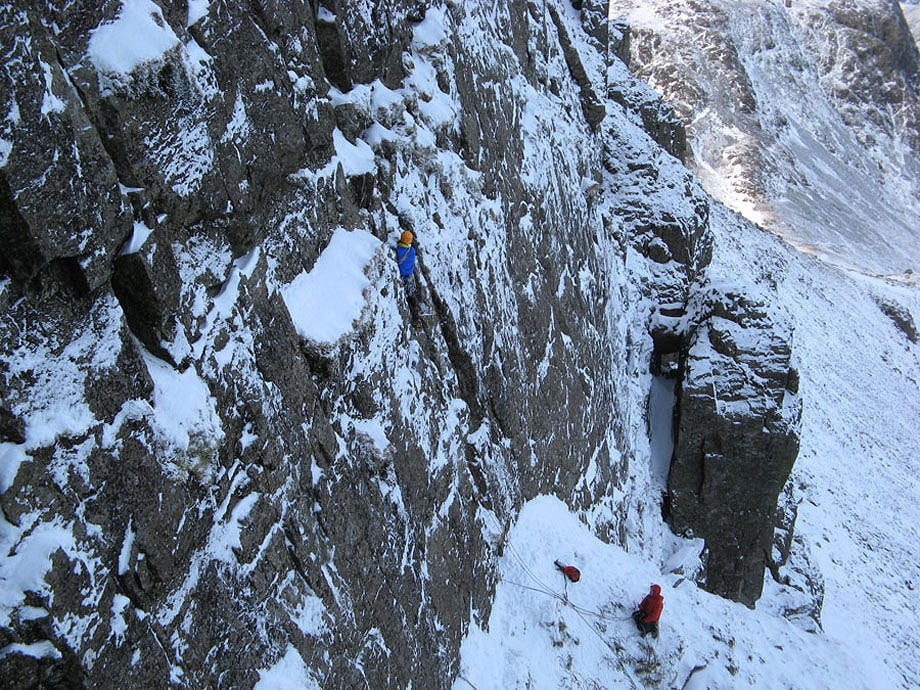
Nick geared up to climb, with Dave belaying, meaning I was free to scramble around and take photos. Looking out over the Buttermere fells, my eyes followed the snowy hills of Galloway out west until I found myself puzzling over some large snowy peaks roughly where I thought the peninsula should finish. It quickly dawned on me that, with the humidity so low, I was able to see the Paps of Jura. I surveyed the valleys immediately below, the echoing silence seeming strange in this landscape that I knew more commonly as temperate, blustery and running with babbling streams.
My view moved back round to Nick, who had by now reached a spike in the groove and inserted his knee to enable a hands-off rest. This was the beginning of his troubles. When he tried and move off, he found that his knee was firmly stuck. Initially Dave and I thought that this would soon be resolved, and lambasted him with predictable taunts: “Serves you right for having such big quads!”; “We'll just have to cut it off!”; “Lets untie and we'll arrange for someone to bring him his Christmas lunch by helicopter!”... Unfortunately, Nick really was stuck, and the silencing of his normally outrageous banter signalled that we potentially had a problem on our hands. Forty five minutes into the situation, and Dave and I started to consider our options. Nick tied-off one rope to a piece of gear above him, while we yarded for all we were worth on the other rope attached to a cam behind the spike in an effort to shift it an inch. It didn't budge. Dave now prussicked up and after some frantic and painful wriggling, Nick's knee was freed.
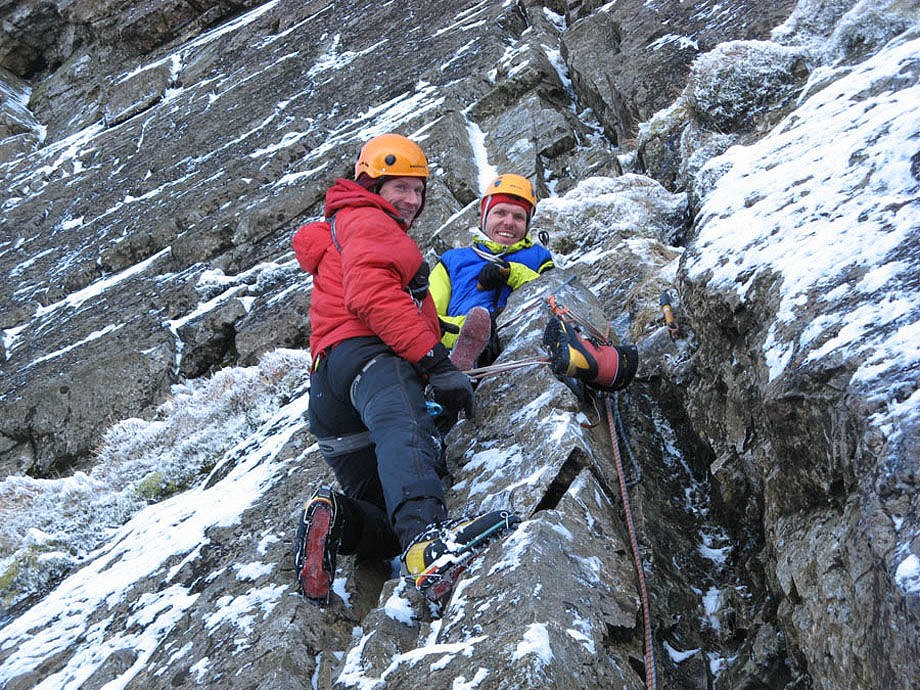
Sore and swollen, Nick didn't get much higher before deciding to take a belay. Looking at the situation – on the shortest day of the year and with a large chunk of the light already gone – I knew that almost all sensible companions would have sacked the route off at this stage. Hollinger, however, had already declared he wanted a proper winter 'beasting'. Looking down from above, the two of them egged me on. Did I mind finishing off in the dark? I thought for a second. This was a final chance to do something faintly loopy – to get cold, scared and pumped in the company of two good friends – before the customary sloth and overconsumption of the Christmas period. Who could turn that down?
Hollinger led the second half of pitch one, which culminated in some very awkward moves to a small sentry box. He then handed over to me – and my worst fears were realised as I set off, with considerable helpings of false-bonhomie and put-on bravado, on the awkward second pitch. Actually, it was one of the most enjoyable pieces of climbing I have ever done. A couple of balancey moves right, protected by a high brass nut, led to good large cams and fist jams in the continuation crack. Moves up this – dusting snow and frost off small crimps for fingers and mono points – led to a rock-over onto a small foot-ledge on the left of the crack. The last section was the hardest: some quite sustained laybacking which saw me getting a bit rad when I jammed both picks and ended up stood on them in order to sling a small spike. “Yeah, Chambers!” shouted Hollinger's Belfast brogue from out of the depths “ – you should be in the circus!”
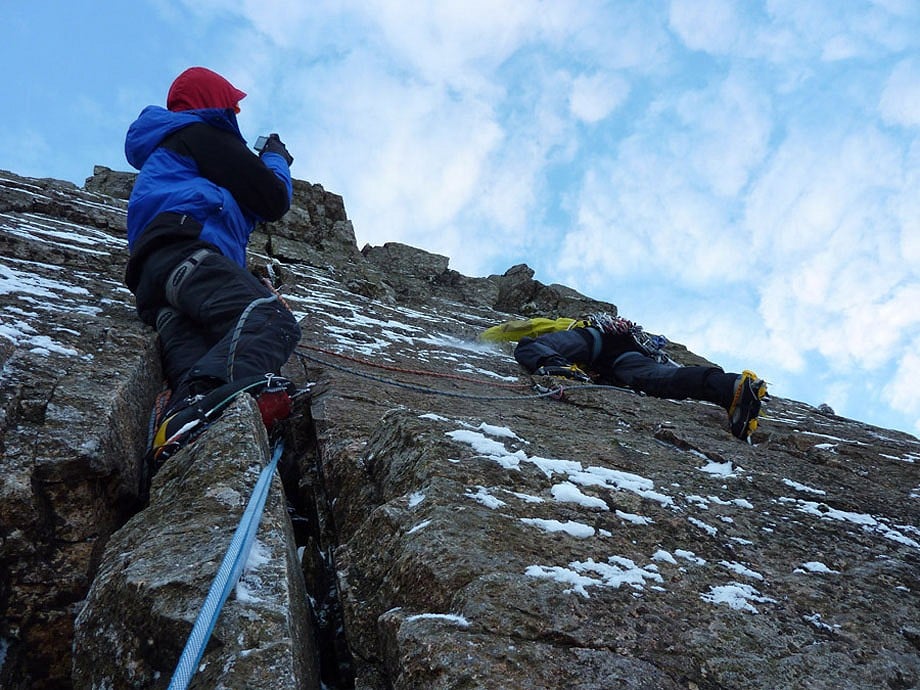
It now went dark. The other two came on up in the gathering gloom, with Wallis left dangling on the foot ledge a few metres down. Out came the head torches. The V-groove looked distinctly out of condition, meaning we would have to take the harder Arete Finish. This meant someone leading technical grade 7 by headtorch. What were we going to do? Deploy the weapon, that's what! Hollinger headed up confidently, his crampons grating on the rock right in front of my nose. He had a slightly manic light in his eyes – or maybe it was just my headtorch glinting – whatever it was, I knew he was fully psyched. He scrabbled out across the wall to the exposed arête. The moon rose, pink and massive, over Penrith. Nick shivered below, the tremors seemingly travelling up his tied-off rope. Suddenly there was a whoop from above. Hollinger had made it to easier ground. At 17:45, two hours after dark, we were all together at the top. “Dave, you're a bloody Jedi!”
So there you have it – Gable Crag is just one of the many good winter climbing venues in the Lake District. Sitting writing this on Boxing Day, full to the brim with wine and Christmas food, I am happy to have got such a haul of classics in so early, and look forward eagerly to the next cold snap! Meanwhile, I'm sure I could fit another roast potato in, so I'm off to the kitchen. Cheers!

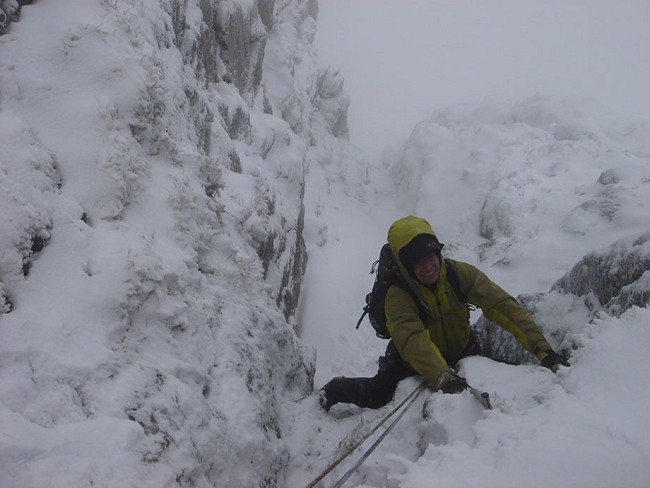
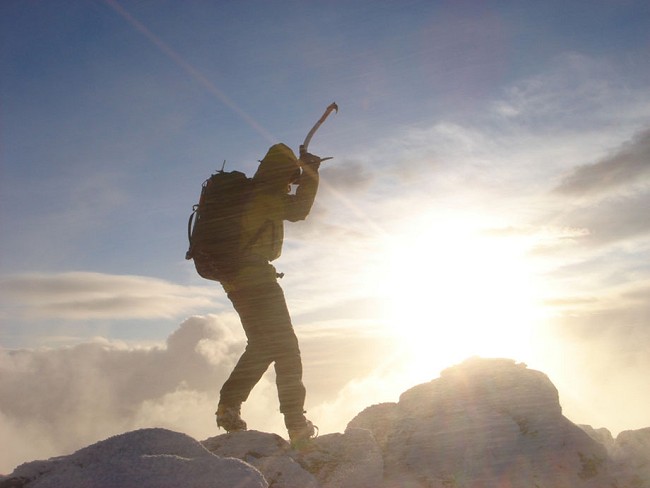
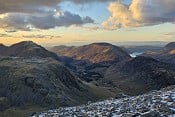



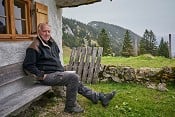


Comments